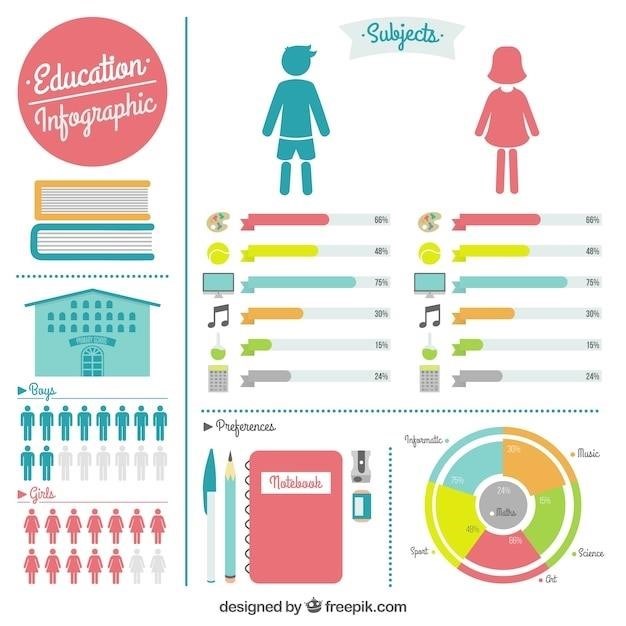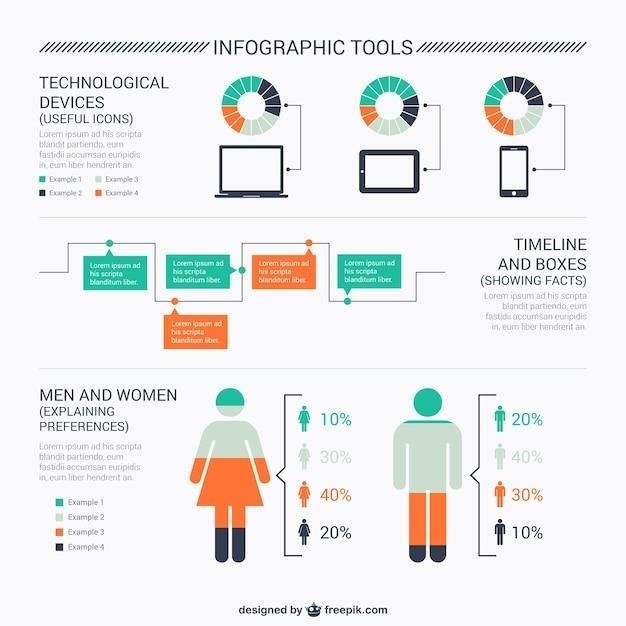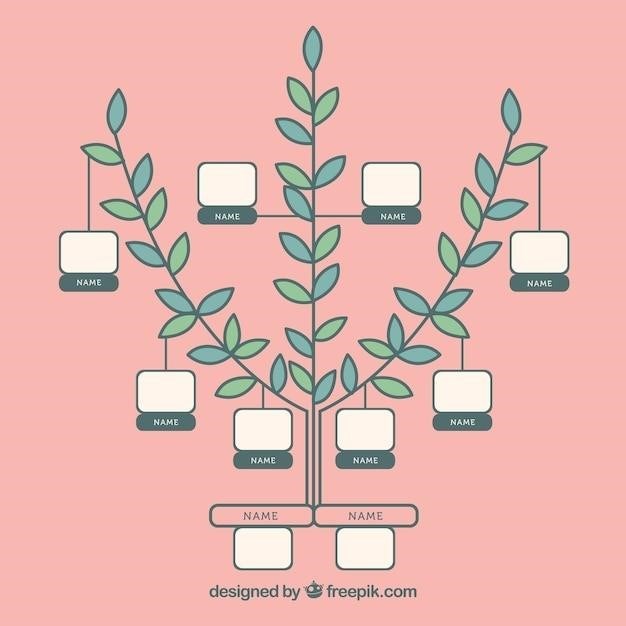Genogram Symbols PDF⁚ A Comprehensive Guide
This comprehensive guide provides a detailed overview of genogram symbols, crucial for creating visual representations of family structures and relationships. Downloadable PDF resources are available for easy reference, facilitating the creation of clear and informative genograms. Understanding these symbols enhances the interpretation of family dynamics and patterns across generations.
Basic Genogram Symbols
Fundamental genogram symbols form the base of any family diagram. The most basic symbols represent gender⁚ a square denotes a male, while a circle represents a female. These are typically accompanied by the individual’s name and birthdate, sometimes including age or date of death. A simple ‘X’ marked through the gender symbol indicates that the person is deceased. Additional details might be added, such as birth order (indicated by numbering within the symbol) or significant life events noted nearby. Understanding these basic building blocks is essential for interpreting the broader context of a genogram. These core elements provide the framework for building a more detailed representation of the family’s history and relationships. The simplicity of these basic symbols ensures clarity and ease of comprehension, making the information readily accessible. A consistent application of these basic symbols is key to creating a well-organized and easily interpretable genogram. The effectiveness of a genogram hinges on the clear presentation of basic information, using these universally understood symbols; Remember to maintain consistency in using these symbols throughout your genogram for better clarity and accuracy. When creating your own genogram, adhering to these standard symbols will ensure that your family tree is easily understood by others.
Standard Symbols for Relationships
Standard symbols for relationships within a genogram clearly illustrate the connections between family members. A horizontal line connecting two basic gender symbols represents a marriage or long-term committed relationship. The addition of dates (marriage, separation, divorce) further clarifies the timeline. A single diagonal line crossing the horizontal line indicates separation, while two diagonal lines signify divorce. These date annotations provide crucial context to the relationship’s duration and status. For unmarried couples cohabitating, a similar horizontal line might be used, but without the additional date specifications unless contextually relevant. The consistent use of these relationship symbols ensures clear communication of family dynamics. These visual cues quickly convey complex relational information, simplifying the understanding of family history. Accurate representation of these relationships is crucial for effective genogram interpretation. Remember to maintain consistency in your use of these symbols for clarity and to avoid ambiguity. The ability to quickly grasp the nature of relationships is fundamental to the genogram’s utility, making these standard symbols essential for effective communication. Using these standard symbols makes your genogram readily understandable by others familiar with genogram conventions.
Symbols for Deceased Individuals
In genograms, representing deceased individuals is achieved through a simple yet impactful visual cue. The most common method involves placing an “X” directly over the standard gender symbol (square for male, circle for female) representing the deceased person. This clearly indicates that the individual is no longer living, providing immediate visual information. Adding the date of death within the symbol itself, perhaps in a smaller font size, provides additional detail without cluttering the diagram. This approach offers a concise and respectful method of acknowledging those who have passed away. Alternatively, some genogram styles might use a different symbol entirely, like a shaded or dimmed version of the standard symbol. However, using an “X” is widely understood and accepted, promoting uniformity and ease of interpretation across different genograms. Regardless of the specific method chosen, consistency in the representation of deceased individuals is vital for ensuring the genogram’s clarity and accuracy. The use of consistent symbols helps avoid misinterpretations and ensures the genogram effectively communicates the intended family history. In all cases, the aim is to maintain a clear visual distinction while preserving a respectful acknowledgment of those who are no longer alive.
Representing Children and Birth Order
Clearly depicting children and their birth order within a genogram is essential for understanding family structures and dynamics. Standard practice involves connecting lines from the parental symbols to represent their offspring. These connecting lines should be clearly drawn and easily distinguishable from other lines within the genogram. To illustrate birth order, children are typically arranged from left to right in the order of their birth. The eldest child is placed on the far left, followed by subsequent siblings in their order of birth. This linear arrangement provides a straightforward visual representation of the family’s chronological order of offspring. For twins, a slightly different approach is often employed. Identical twins are represented by connecting a single line to two symbols placed side-by-side, while fraternal twins are shown with two separate lines emanating from the parents, each connecting to an individual symbol for each twin. This differentiation provides valuable information about the sibling relationship. While slight variations might exist in specific genogram styles, maintaining consistency in the depiction of children and their birth order is paramount for clear communication. Using standard, easily understood representations ensures that the genogram accurately and efficiently conveys critical family information.

Special Circumstances⁚ Adoption, Foster Care

Genograms offer a valuable tool for representing complex family structures, including adoptions and foster care arrangements. Standard symbols often utilize distinct notations to differentiate adopted or foster children from biological offspring. A common method involves using a distinct symbol, such as a small, dotted line connecting the child symbol to the adoptive or foster parents. This visually separates them from biologically related children. Alternatively, some genogram systems employ a specific symbol for the child itself, such as a differently shaped symbol or a symbol with a unique annotation. Regardless of the chosen method, it’s essential to maintain consistency throughout the genogram to avoid confusion. Additionally, it may be beneficial to include a key or legend to clarify the meaning of any unique symbols used. This is particularly helpful when dealing with multiple adoptions or foster care arrangements within one family. The inclusion of additional information, such as dates of adoption or foster care placement, can further enrich the genogram and increase its overall informational value. By clearly outlining these special circumstances, genograms provide a comprehensive overview of family history, including the various relationships and unique life experiences of its members.
Advanced Genogram Symbols⁚ Medical Conditions
Expanding beyond basic family structures, advanced genogram symbols allow for the inclusion of crucial medical information, enhancing the genogram’s utility for healthcare professionals and family members alike. These symbols provide a visual representation of hereditary conditions, facilitating the identification of patterns and potential risks within a family. Common symbols may include shaded or colored shapes to denote specific conditions, while others use abbreviations or short descriptions written within or near the individual’s symbol. Consistency in the use of these symbols is essential for accurate interpretation. A key or legend accompanying the genogram is highly recommended, especially when numerous medical conditions are represented. This key should clearly define each symbol and its corresponding condition, ensuring clarity and preventing misinterpretations. The level of detail included depends on the purpose of the genogram and the privacy preferences of the individuals involved. While specific diseases can be noted, maintaining confidentiality is paramount, especially when dealing with sensitive or stigmatized conditions. Careful consideration should be given to the ethical implications of including medical information, ensuring informed consent is obtained whenever possible. By incorporating medical conditions, the genogram becomes a powerful tool for understanding health trends and facilitating proactive healthcare decisions within a family.
Advanced Genogram Symbols⁚ Psychological Conditions
Genograms extend beyond basic familial relationships to encompass the complexities of mental health. Representing psychological conditions within a genogram requires sensitivity and careful consideration of privacy. Specialized symbols, often incorporating color-coding or distinct markings, can represent conditions such as depression, anxiety, or personality disorders. A key explaining the symbols used is crucial for accurate interpretation. Consistency in symbol usage ensures clarity and avoids confusion. The level of detail included should be determined by the genogram’s purpose and the individuals’ willingness to share sensitive information. Ethical considerations are paramount; obtaining informed consent is vital when including potentially stigmatizing information. While the genogram aims to provide a holistic view of family dynamics, respecting individual privacy and avoiding judgmental labeling is essential. Using these advanced symbols responsibly allows for a more comprehensive understanding of the interplay between family relationships and mental well-being, potentially aiding in identifying patterns and risk factors. This nuanced approach encourages open communication and facilitates more informed support systems within the family.
Advanced Genogram Symbols⁚ Addictions
Incorporating information about addictions into a genogram requires a thoughtful and ethical approach. Specific symbols can represent various addictions, such as alcohol, drugs, gambling, or compulsive behaviors. These symbols, often distinct from those used for other health conditions, should be clearly defined in a accompanying key. The level of detail included should respect the privacy of individuals and be consistent with their consent. Using standardized symbols helps maintain clarity and consistency across different genograms. It’s crucial to avoid stigmatizing language or judgments when depicting addictions. The focus should remain on understanding the impact of addiction on family dynamics and potential intergenerational patterns. Remembering that addiction is a complex health issue, the genogram should be used as a tool for understanding, not for labeling or judgment. This section of the genogram should be approached with sensitivity, recognizing the potential emotional impact on family members. Clear communication and transparency are crucial when using these symbols, ensuring individuals understand the purpose and implications of including addiction information in the visual representation of their family history.
Interpreting Genogram Symbols⁚ Key Considerations
Accurate interpretation of genogram symbols requires careful attention to detail and context. Understanding the specific meanings assigned to each symbol within the genogram’s key is paramount. Consider the potential for variations in symbol usage across different resources or practitioners. Always refer to the accompanying key to ensure consistent interpretation. The arrangement of symbols and the connections between them provide valuable insights into family relationships and dynamics. Patterns of relationships, such as recurring marital conflicts or specific health issues across generations, may become apparent. Note that the genogram represents a snapshot in time; relationships and circumstances may evolve over time. The information presented should be considered within its broader context, including cultural and societal influences on family structures and behaviors. Remember that the genogram is a tool for understanding, not a definitive judgment on individuals or family structures. Be mindful of potential biases in interpretation, striving for objective analysis based on the available data. When interpreting a genogram, consider involving multiple perspectives to gain a more comprehensive understanding of the family’s history and dynamics. Ethical considerations regarding privacy and confidentiality should always guide the interpretation and use of this information.
Downloadable PDF Resources of Genogram Symbols
Numerous online resources offer downloadable PDF files containing comprehensive lists of genogram symbols. These PDFs often include visual representations of each symbol, along with clear explanations of their meanings. This readily accessible format allows for easy printing and use during therapy sessions or family discussions. The availability of these downloadable resources eliminates the need for manual creation of symbol keys, saving time and ensuring consistency. Many websites dedicated to family therapy or counseling provide free downloadable PDF guides, while others may offer premium versions with additional features or more detailed information. When selecting a PDF resource, it’s important to verify the source’s credibility and accuracy. Reliable sources will provide clearly defined symbols and explanations, ensuring accurate interpretation. Some PDFs may include customizable templates, enabling users to create personalized genograms tailored to specific needs. Using a standard set of symbols from a reputable PDF ensures clarity and consistency when sharing genograms with other professionals or family members. Remember to check copyright information before distributing or modifying downloaded PDFs.
